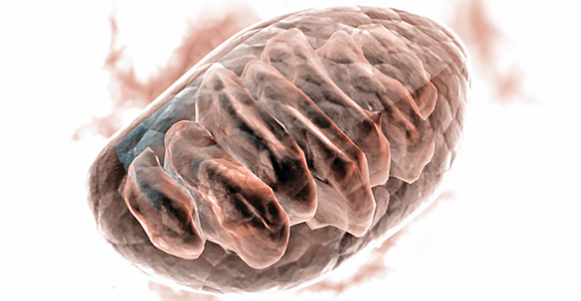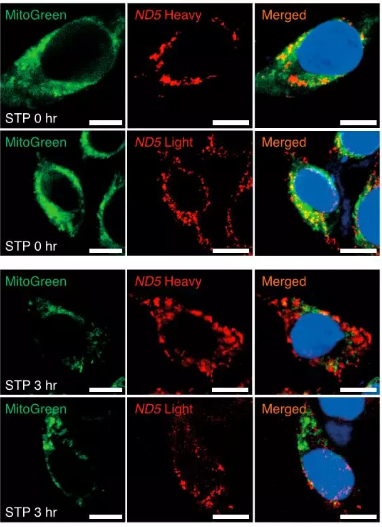mtRNA Analysis (FISH)
Mammalian mitochondria contain a small circular genome, which encodes 2 ribosomal RNAs, 22 tRNAs, and 13 essential protein subunit. The transcription and translation machineries in the mitochondrial matrix require both mitochondrion-encoded RNAs and nucleus encoded protein and RNA factors. Mitochondrial RNAs (mtRNAs) are first transcribed as polycistronic transcripts from both H-strand and L-strand, and the transcripts are dissected by RNA processing enzyme into individual rRNAs, tRNAs, and mRNAs. These rRNAs and tRNAs together with translational factors imported from cytosol then synthesize the proteins from the mRNAs.
Mitochondrial RNA homeostasis is one of the key elements in regulating mitochondrial functions. Mitochondria have to quickly respond to external stimuli and are constantly going through fusion and fission, which is directly linked to their biosynthesis and requires fast changes of their gene expression. Much is understood about mtRNA synthesis and processing. But distinct localization of mitochondrial RNA (mtRNA) and the molecular mechanism are poorly understood.
It is well known among researchers that mitochondrial genetic or primary mitochondrial disorders contribute to mitochondrial dysfunction. Beyond the evaluation of mtDNA, levels of mitochondrial RNA (mtRNA) and mitochondrial regualtory genes can provide additional information regarding the risk of clinically improtant mitochondrial damage. Fluorescence in situ hybridization (FISH) provides a reliable tool for charaterizing the fate and location of mtRNA. Creative Bioarray offers the detection of mtRNA in your specific studies.
 Fig 1. Mammalian mitochondria
Fig 1. Mammalian mitochondria
 Fig 2. Cytosolic release of mtRNAs can be visualized in situ using RNA ISH. Bar indicates 10 µm.
Fig 2. Cytosolic release of mtRNAs can be visualized in situ using RNA ISH. Bar indicates 10 µm.
Kim Y, Park J, Kim S, et al. PKR senses nuclear and mitochondrial signals by interacting with endogenous double-stranded RNAs[J]. Molecular cell, 2018, 71(6): 1051-1063. e6.
Application:
- Mitochodrial Function Study
- dsRNA Related Study
Features:
- Accurate - In Situ Detection Service - Custom design your probe
- Value - We focus on the quality of our service and all supported by competitive pricing
- Efficiency - We are able to provide the fastest turnaround time of any supplier in the industry
Creative Bioarray offers custom mtRNA Analysis services for your scientific research as follows:
- Probe design
- Probe synthesis
- Sample (Cells/FFPE/Others) preparation
- Imaging
- Data analysis
References
- Kim Y, et al. PKR senses nuclear and mitochondrial signals by interacting with endogenous double-stranded RNAs[J]. Molecular cell, 2018, 71(6): 1051-1063. e6.
- Birkus G.; et al. Assessment of mitochondrial toxicity in human cells treated with tenofovir: comparison with other nucleoside reverse transcriptase inhibitors[J]. Antimicrobial agents and chemotherapy, 2002, 46(3): 716-723.
- Bobrowicz A J.; et al. Polyadenylation and degradation of mRNA in mammalian mitochondria: a missing link?[J]. 2008.
- Nicolson G L. Mitochondrial dysfunction and chronic disease: treatment with natural supplements[J]. Integrative Medicine: A Clinician's Journal, 2014, 13(4): 35.
- Liu P.; et al. Mammalian mitochondrial RNAs are degraded in the mitochondrial intermembrane space by RNASET2[J]. Protein & cell, 2017, 8(10): 735-749.